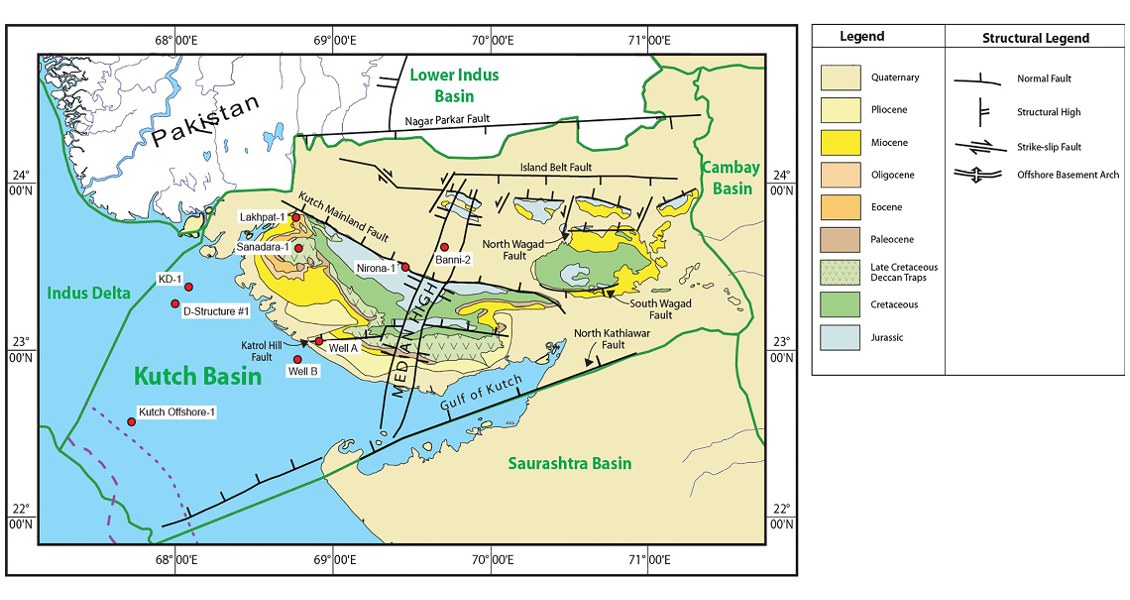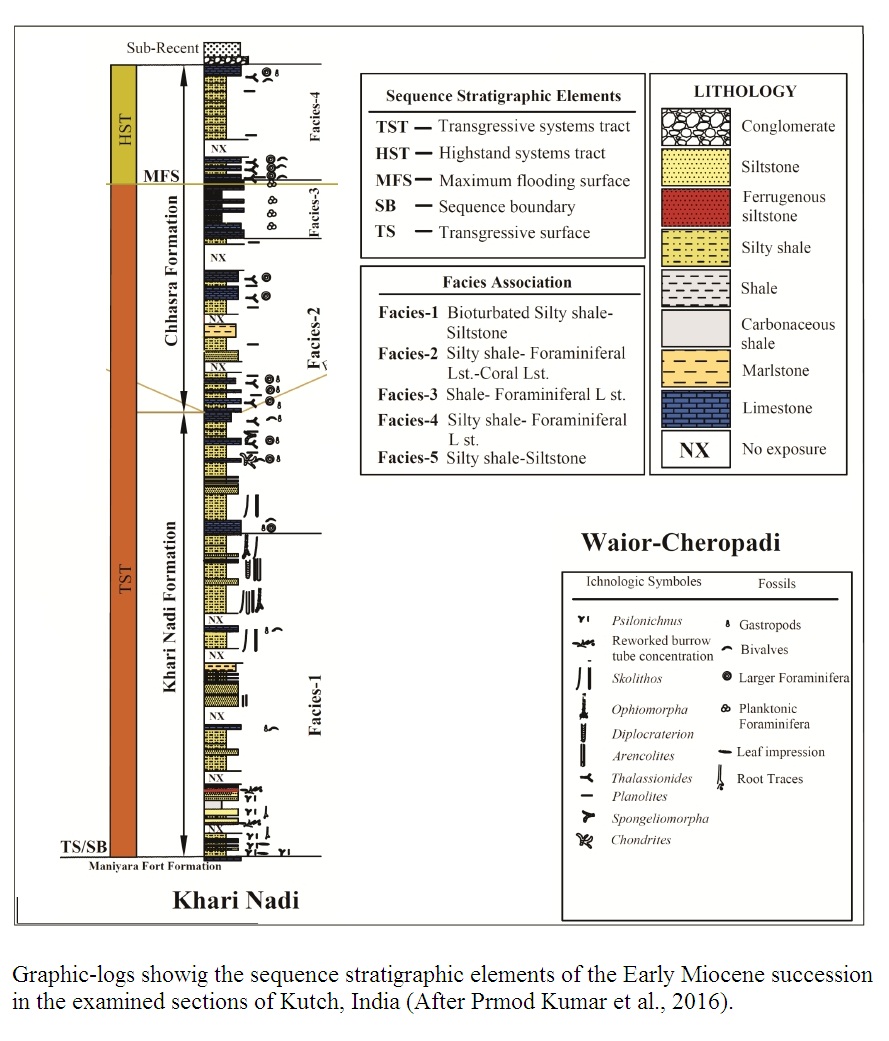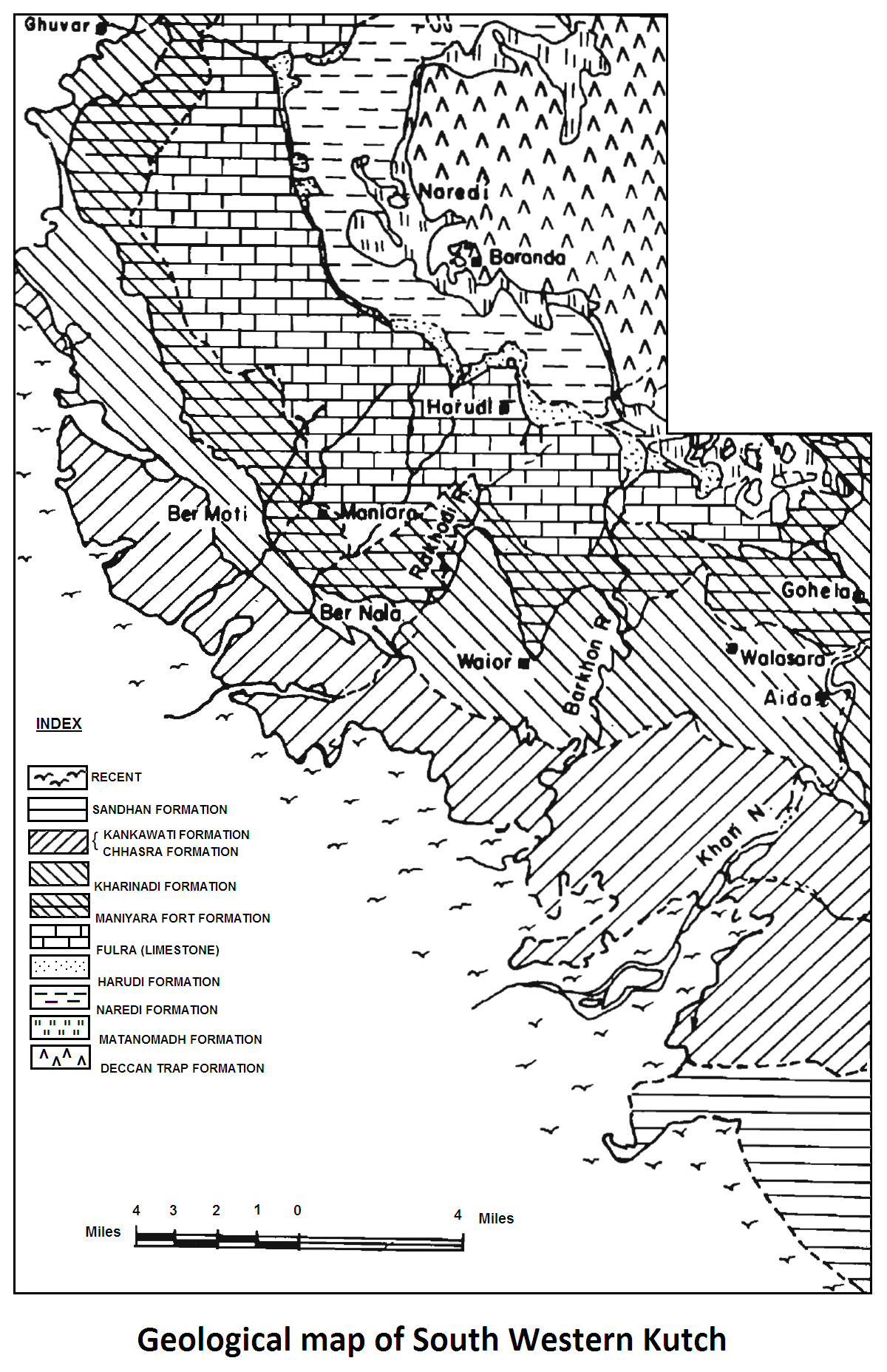Khari Nadi Fm
Type Locality and Naming
OUTCROP. Named after River Khari Nadi. [Original Publication: Biswas, S.K. and Raju, D.S.N. (1971) Note on the rock stratigraphic classification of the Tertiary sediments of Kutch Quart. Jour. Geol. Min. Met. Soc. India.]
Synonyms: The other related but informal names are: Arenaceous Group (Wynne, 1872) and Gaj Beds (Poddar, 1959; Mohan and Bhatt, 1968). A distinctive sequence of fine grained to silty, variegated sandstones overlying the white foraminiferal limestones of the Fulra Fm and Maniyara Fort Fm is defined as the Khari Nadi Formation (Source: Pandey and Dave, 1998).
[Fig. Geological and structural map of Kutch, also showing the onshore and offshore wells drilled for oil exploration. (Map by Rasoul Sorkhabi in GeoExpro Dec2014, based on various sources including S.K. Biswas, Current Science, 25May2005)]
Lithology and Thickness
Claystone. Lower part of the Khari Nadi Fm in the Khari Nadi section is characterized by silty shale and thin beds of siltstone. This part is barren of mega-and microfossils and contains gypsum laminae parallel to the bedding plane at the base. It consists of small scale wave rippled siltstone and silty shale alternations with vertical burrows of Psilonichnus. The silty shale contains rootlets and leaf impressions at places. A distinct concentration of reworked burrow tubes characterizes the lower part of the succession. The burrow tubes were eroded from the underlying units and were re-deposited as 30 cm thick bed having appearance of a conglomerate bed. The reworked Psilonichnus burrow tubes are closely spaced and occur at two stratigraphic levels in the lower part of Khari Nadi Formation along Khari Nadi and Waior-Cheropadi sections.
Middle part of the Khari Nadi Formation is characterized by extensively burrowed silty shale having mottled and variegated appearance because of extensive bioturbation. The representative Skolithos assemblage namely, Skolithos, Diplocraterion, Arenicolites and Ophiomorpha characterizes this part. Some of the stratigraphic horizons are thoroughly bioturbated causing complete obliteration of sedimentary features. A hard, compact and impure limestone (20-30 cm thick) containing shells of oyster, Pecten, bryozoans, gastropods, larger benthic foraminifera, barnacles and serpulids occur near the top. The skeletal elements are highly fragmented representing variable preservation state. The fossiliferous bed rests on erosional surface of underlying silty shale and it is identified as lag concentration (Kumar et al., 2009). This is followed by a thick bed of friable, micaceous, cross-stratified siltstone overlain by a 50 cm thick marlstone bed.
Upper part of the Khari Nadi Formation is characterized by a few impure limestone beds, separated by silty shale and siltstone beds. The limestone beds contain well-preserved gastropods, oysters, barnacles and larger benthic foraminifera. In the Kankawati River section only the upper part of Khari Nadi Formation is exposed (Source: Pramod Kumar et al., 2016).
[Figure 1: Graphic Logs showing the sequence stratigraphic elements of the early Miocene succession in the examined section of Kutch. (after Pramod Kumar et al., 2016)]
[Figure 2: Geological Map of South Western Kutch (after Biswas and Raju, 1973)]
[Figure 3: Stratigraphic Column of holostratotype of the Khari Nadi Formation and Aida regional stage (after Raju, 1974)]
Relationships and Distribution
Lower contact
Lower boundary to the Maniyara Fort Fm is an unconformity and is fixed at the top of the Spiroclypeus limestone and at the base of bluish grey claystone beds.
Upper contact
Upper boundary with the Chassara Fm is conformable and gradational. It is fixed at the base of about 1 m thick marlite bed exposed in 10 m cliff of Khari Nadi and its prominent elbow bend, east of Laiyari.
Regional extent
GeoJSON
Fossils
The lower part of the Khari Nadi Formation (30m) is barren of microfossils. The first occurrence of microfossils in Khari Nadi section recorded at 35 m with occurrence of Quinqueloculina, Ammonia, Cibicides and Discorbis. The upper part of the Khari Nadi Formation is largely barren except for limestone beds which host oyster, Pecten, barnacles, gastropods, polycheate tubes, bryozoans and larger foraminifera species Miogypsina (Miogypsina) tani, Miogypsina (Miogypsinoides) dehaartii, and Lepidocyclina (Raju, 1974; 1991; Kumar and Saraswati, 1997)
The abundance of foraminifera in the Claystone Member of the Chassara Fm is medium to high. It consists of a diverse assemblage of benthic foraminifera including Ammonia, Brizalina, Bulimina, Elphidium, Florilus, Cibicides, Discorbis, Nodosaria, Lagena, Quinqueloculina, Pararotalia and Glandulina. (Source; Pramod Kumar et al., 2016).
Age
Depositional setting
Paleoenvironment varies from tidal flat, littoral to shallow-inner shelf. Two transgressive cycles are recognized in the type section.
Additional Information



